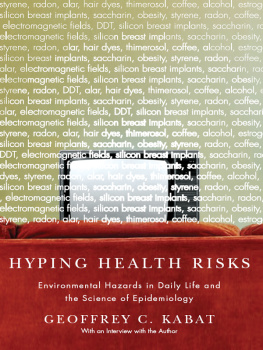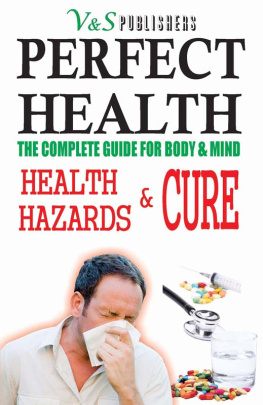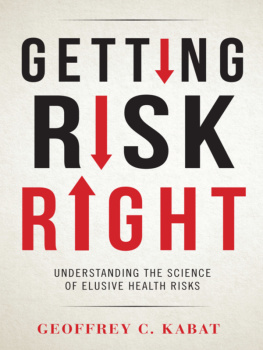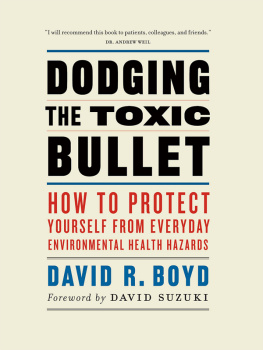Praise for Hyping Health Risks
For students in the health sciences, health journalists, and policymakers, the case studies provide information on their respective topics and also serve as lucid demonstrations of epidemiologic reasoning. For sociologists, historians of science, and media scholars, the case studies can be starting points for further exploration. And for educated general readers, the book can engage and enlighten regarding the complex context in which known and suspected health risks are identified, explored, and acted on.
Barbara Gastel, Texas A&M University,
review in New England Journal of Medicine
Kabat, who wrote Hyping Health Risksa fascinating and detailed examination of how we fell for certain, illusory environmental hazardsis possibly the only epidemiologist in the world to have also published a book on Dostoyevsky (he got a Ph.D in Russian and comparative literature from Columbia before switching tracks). And the background in literary analysis and theory adds a crucial ability to explain why we, as a society, are prone to turning hypothetical risks into social facts. The upshot is that most public alarms about health risks dispense with the tools required to make sense of the alarmand we end up with disembodied findings and ideology.
Trevor Butterworth, Forbes
Health scares come and go, but they often have a tenuous scientific basis. Kabat, a cancer epidemiologist, systematically rips through cancer alerts that overrode scientific rigor in recent decades. In so doing, he dispels the dubious science underlying the scares and explains how public confusion can come about.... He extends his critique to debates linking radon gas exposure and secondhand cigarette smoke exposure to lung cancer. Those chapters will ruffle some feathers, but Kabat is unafraid of controversy.
Nathan Seppa, ScienceNews
Reading this book will give you a better understanding of what epidemiology can and cant do, and insight into how the rational scientific process can be perverted by the press, politicians, and grass-roots activists.
Harriett Hall, Science-Based Medicine Web site
This book does an exceptionally good job, first by putting epidemiology within the context of pubic health and then by explaining key terms, concepts, and methods. It provides a penetrating treatment of a difficult and complex subject in a readily understandable way.
Steven D. Stellman, Mailman School of Public Health,
Columbia University
HYPING HEALTH RISKS
Environmental Hazards in Daily Life and the Science of Epidemiology
G EOFFREY C. K ABAT
COLUMBIA UNIVERSITY PRESS

NEW YORK
Columbia University Press
Publishers Since 1893
New York Chichester, West Sussex
cup.columbia.edu
Copyright 2008 Columbia University Press
Paperback edition, 2012
All rights reserved
E-ISBN 978-0-231-51196-4
Library of Congress Cataloging-in-Publication Data
Kabat, Geoffrey C.
Hyping health risks : environmental hazards in daily life and the science of epidemiology / Geoffrey C. Kabat
p. cm.
Includes bibliographical references and index.
ISBN 978-0-231-14148-2 (cloth : alk. paper)ISBN 978-0-231-14149-9 (pbk. : alk.)ISBN 978-0-231-51196-4 (e-book)
1. Health risk assessmentSocial aspectsUnited States
2. Epidemiology 3. Environmental health. I. Title.
RA566.27.K33 2009
615.902dc22
2008007285
A Columbia University Press E-book.
CUP would be pleased to hear about your reading experience with this e-book at .
References to Internet Web sites (URLs) were accurate at the time of writing. Neither the author nor Columbia University Press is responsible for URLs that may have expired or changed since the manuscript was prepared.
For Roberta and Daniel
and to the memory of Elvin A. Kabat
We, the scientific community, should take the blame for this. Toxicologists, and Im one of them, have perpetuated the idea that if 100 molecules are going to kill you, then one molecule is going to kill 1 percent of somebody. We have a tremendous ability to analyze anything and everything.
Michael A. Gallo
CONTENTS
We live in a society that conditions us to be hyperattuned to anything that may affect our health. In spite of dramatic improvements in longevity and medical care in recent decades, it seems that we feel our health and wellbeing are, if anything, more vulnerable to a myriad of external and internal threats. Doubtless, a major contributor to these feelings of vulnerability is the fact that we are constantly bombarded with news of novel health hazards that lurk in our everyday lives. Many of these hazards, even some that provoke regulatory action, have been greatly overblown. But somehow, the news announcing the demise, or the downgrading, of a hazard does not put us at ease to anywhere near the same extent that the announcement of a new hazard galvanizes our concern. How do certain low-level hazards get selected for attention, while others that may be of much greater consequence receive little attention? What are the factorsthat is the professional specialties, social groups, institutions, and beliefscontributing to the inflating of health risks? What are the consequences of this skewing of what is, after all, vital information for the public at large? Finally, on the most practical level, how are we to distinguish between exposures that have important effects on health and those likely to have minimal, or no, effect? These are some of the central questions this inquiry focuses on.
The idea for this book dates from the early 1990s, when I served on a committee convened by the U.S. Environmental Protection Agency on the question of the health effects of exposure to secondhand tobacco smoke. The committees charge was to comment on a lengthy document that had been drawn up by the agency before it was approved for publication. As a member of the committee, I attended two meetings that were open to the public and at which all interested parties had an opportunity to give comments. In addition to the roughly fifteen panel members, there were numerous speakers representing the tobacco industry on the one hand and anti-smoking groups on the other, as well as interested individuals. What was most striking about the proceedings was how neatly the attendees were divided into two camps. Almost all of the speakers had a strong position either endorsing or criticizing the central conclusions of the report, i.e., that secondhand tobacco smoke was a known human carcinogen responsible for about 3,000 lung cancer deaths each year in nonsmokers. The members of the panel, to be sure, raised questions about specific aspects of the report. However, virtually no one, aside from the tobacco industry representatives, devoted attention to the weaknesses of the epidemiological studies of passive smoking on which its conclusions were largely based. Furthermore, no one questioned whether the reports conclusion, as stated, was scientifically justified. It was as if in this forum such questions were off-limits.
I had been invited to serve on the committee because, starting in the early 1980s, I had carried out studies of the health effects of both active and passive smoking as an epidemiologist working with Ernst L. Wynder at the American Health Foundation in New York City. As a medical student, in 1950, Wynder had published one of the first studies demonstrating that cigarette smoking was a cause of lung cancer, and he went on to become a major figure in preventive medicine and a lifelong crusader against smoking. As someone who had conducted one of the early studies on passive smoking and was familiar with the scientific literature on this topic, my position was that it was entirely plausible that exposure to secondhand tobacco smoke, or environmental tobacco smoke (ETS), could cause some additional cases of lung cancer and other diseases among people who had never smokedespecially those with heavy and prolonged exposure and with a constitutional susceptibility. Furthermore, I saw no rational justification for anyone to be exposed to this totally unnecessary and avoidable form of air pollution.









 NEW YORK
NEW YORK